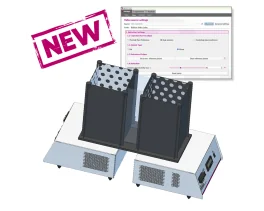Authors
E. Barreiro, J. Marín-Corral, F. Sanchez, V. Mielgo, F. J. Alvarez et al.
Lab
Barcelona Biomedical Research Park (PRBB), Universitat Pompeu Fabra, Pulmonology Department-Muscle and Respiratory System Research Unit, Barcelona, Catalonia, Spain.
Journal
Journal of Animal Physiology and Animal nutrition
Abstract
Skeletal muscle dysfunction is a common systemic manifestation in several prevalent diseases. Predictive values are useful tools for the diagnosis and prognosis of diseases. In experimental animals, no reference values of muscle function evaluation have been so far reported. The objective was to obtain predictive values of maximal inspiratory pressure (MIP) and grip strength measurements in healthy rats. In 70 healthy rats, MIP and grip strength were measured in vivo weekly for five consecutive weeks using non-invasive methodologies. Three ranges of rat body weights (250-299, 300-349 and 350-399 g) and lengths (37.0-41.0, 41.1-42.0 and 42.1-44.0 cm) were established. MIP and grip strength measurements falling within the ranges of weight 350-399 and 300-349 g and length 42.1-44.0 cm were significantly greater than values falling within 250-299 g and 37.0-41.0 cm ranges respectively. Specific weight- and length-percentile distributions for MIP and grip strength measurements were calculated. As significant direct correlations were observed between rat weights and lengths and either MIP or grip strength measurements, regression equations relating all these variables were also determined. Skeletal muscle dysfunction is frequently associated with highly prevalent conditions. The significant predictive equations described for both MIP and grip strength measurements will enable scientists to better estimate the respiratory and peripheral muscle dysfunctions of laboratory animals, especially when conducting follow-up and/or intervention investigations.
Source :
http://onlinelibrary.wiley.com/doi/10.1111/j.1439-0396.2010.01027.x/abstract

 Pain - Thermal Allodynia / Hyperalgesia
Pain - Thermal Allodynia / Hyperalgesia Pain - Spontaneous Pain - Postural Deficit
Pain - Spontaneous Pain - Postural Deficit Pain - Mechanical Allodynia / Hyperalgesia
Pain - Mechanical Allodynia / Hyperalgesia Learning/Memory - Attention - Addiction
Learning/Memory - Attention - Addiction Physiology & Respiratory Research
Physiology & Respiratory Research











![Dynamic Weight Bearing 2.0 – Postural Module [Add-on]](https://bioseb.com/733-home_default/dynamic-weight-bearing-20-add-on-postural-module.jpg)
























 Pain
Pain Central Nervous System (CNS)
Central Nervous System (CNS) Neurodegeneration
Neurodegeneration Sensory system
Sensory system Motor control
Motor control Mood Disorders
Mood Disorders Other disorders
Other disorders Muscular system
Muscular system Joints
Joints Metabolism
Metabolism Cross-disciplinary subjects
Cross-disciplinary subjects CONFERENCES & MEETINGS
CONFERENCES & MEETINGS